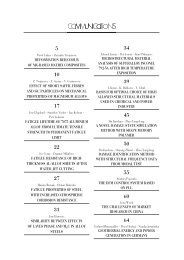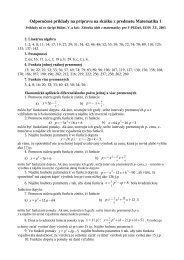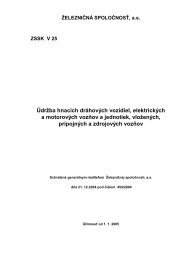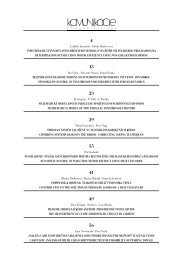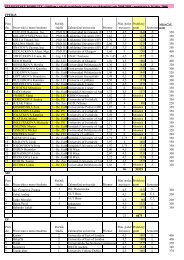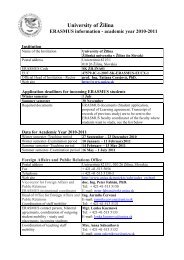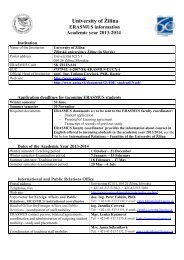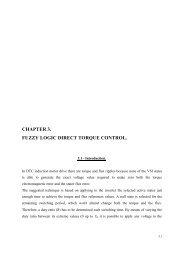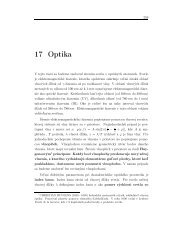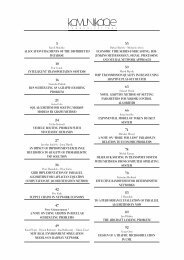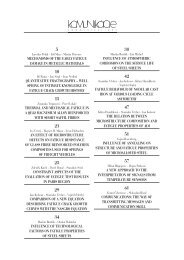Jozef Jandacka – Stefan Papucik – Vladimir Dekys – Richard Melicher *AN ANALYSIS OF AIR FLOW AT VARIOUS SPACING OF FANSON A PHYSICAL MODEL OF A ROAD TUNNELIn this article, <strong>the</strong> influence <strong>of</strong> a jet fan spacing in a longitudinal air conditioning system in a road tunnel on a physical model <strong>of</strong> <strong>the</strong>tunnel is analyzed. The analysis <strong>of</strong> air transport on a physical model with a length <strong>of</strong> 30 metres was accomplished for various combin<strong>at</strong>ions<strong>of</strong> <strong>the</strong> connection <strong>of</strong> 8 jet fans (parallel connection <strong>of</strong> 8 fans, combined connection <strong>of</strong> 2 4 parallel fans, combined connection (<strong>of</strong>) 4 2parallel fans and serial connection <strong>of</strong> 8 fans). From <strong>the</strong> analysis <strong>of</strong> measurement on <strong>the</strong> physical model follows wh<strong>at</strong> a big influence <strong>the</strong> fanspacing has on <strong>the</strong> speed pr<strong>of</strong>ile, which to a gre<strong>at</strong> extent influences air transport in <strong>the</strong> tunnel. Our contribution deals with <strong>the</strong> interpret<strong>at</strong>ion<strong>of</strong> vibr<strong>at</strong>ion d<strong>at</strong>a from <strong>the</strong> point <strong>of</strong> view <strong>of</strong> vibr<strong>at</strong>ion sources identific<strong>at</strong>ion. These sources are searched and evalu<strong>at</strong>ed from <strong>the</strong> measured d<strong>at</strong>ausing a frequency and phase spectrum.1. IntroductionNowadays, transport in connection with <strong>the</strong> construction <strong>of</strong>transport infrastructure is moved much more <strong>of</strong>ten through undergroundtunnels, especially in mountainous regions and town agglomer<strong>at</strong>ions.This brings, though, a whole variety <strong>of</strong> problems withitself, which need to be solved reliably. This concerns <strong>the</strong> securing<strong>of</strong> <strong>the</strong> required volume flow r<strong>at</strong>e <strong>of</strong> fresh air for ventil<strong>at</strong>ion <strong>at</strong> anoptimum energy demand <strong>of</strong> vent system, a suitable way <strong>of</strong> ventingexhaust emissions with a minimiz<strong>at</strong>ion <strong>of</strong> environmental pollutionin <strong>the</strong> surrounding <strong>of</strong> <strong>the</strong> tunnel and a minimiz<strong>at</strong>ion <strong>of</strong> securityrisks <strong>at</strong> collisions in <strong>the</strong> tunnel especially.A very <strong>of</strong>ten used way <strong>of</strong> venting <strong>the</strong> road tunnels is, especiallyin shorter tunnels, a longitudinal ventil<strong>at</strong>ion, Fig.1, [1], [4].From <strong>the</strong> point <strong>of</strong> view <strong>of</strong> <strong>the</strong> jet fan oper<strong>at</strong>ion safety, vibr<strong>at</strong>ionsplay an important role. Because <strong>of</strong> this, increased <strong>at</strong>tentionhas to be paid to <strong>the</strong>m. The measurements <strong>of</strong> <strong>the</strong> vibr<strong>at</strong>ions haveto be checked <strong>at</strong> least every 6 months and in <strong>the</strong> initial oper<strong>at</strong>ioneven more <strong>of</strong>ten. The vibr<strong>at</strong>ion degree in <strong>the</strong> horizontal and verticaldirections has to be checked <strong>at</strong> <strong>the</strong> measuring points which weremarked out during <strong>the</strong> first measurement. If <strong>the</strong> vibr<strong>at</strong>ion valuesare extremely different, <strong>the</strong> reasons <strong>of</strong> <strong>the</strong>ir origin<strong>at</strong>ion have to befound (e.g. dust on <strong>the</strong> fan blades). In case <strong>of</strong> a vibr<strong>at</strong>ion increase,it is necessary to correct <strong>the</strong> balance <strong>of</strong> <strong>the</strong> fan. The increase <strong>of</strong>vibr<strong>at</strong>ions can cause <strong>the</strong> destruction <strong>of</strong> <strong>the</strong> fan and a guaranteedexpir<strong>at</strong>ion <strong>of</strong> conditions. At higher vibr<strong>at</strong>ions it is recommendedto check <strong>the</strong> fan more <strong>of</strong>ten than within 6 months. The vibr<strong>at</strong>ionsduring an oper<strong>at</strong>ion should not exceed <strong>the</strong> value <strong>of</strong> 2.8 mm/s [5].In this article, <strong>the</strong> influence <strong>of</strong> a jet fan spacing <strong>at</strong> a longitudinalventil<strong>at</strong>ing system in <strong>the</strong> road tunnel on a physical model <strong>of</strong> <strong>the</strong>tunnel is analysed. This article also introduces <strong>the</strong> way <strong>of</strong> vibr<strong>at</strong>ionmeasurement and <strong>the</strong> analysis <strong>of</strong> measured values [7], [8].Fig. 1 Longitudinal ventil<strong>at</strong>ion with jet fansNowadays, based on <strong>the</strong> knowledge and consequences <strong>of</strong> firesin <strong>the</strong> tunnels in Western Europe, <strong>the</strong> increased <strong>at</strong>tention is paidto venting and to <strong>the</strong> design <strong>of</strong> ventil<strong>at</strong>ing systems <strong>of</strong> road tunnels,which are an essential part <strong>of</strong> fire safety assurance in <strong>the</strong> tunnel.Calcul<strong>at</strong>ions are still applied <strong>at</strong> designing ventil<strong>at</strong>ing systems,which are based on <strong>the</strong> <strong>the</strong>ory <strong>of</strong> one-dimensional flow and onexperiments on already existing road tunnels. In many cases, toanalyse some problems <strong>of</strong> ventil<strong>at</strong>ion in labor<strong>at</strong>ory conditions onphysical models has shown to be very suitable [2], [3].2. Physical modelThe physical model was realized in <strong>the</strong> r<strong>at</strong>io 1:10 to <strong>the</strong> realroad tunnel. This model is shown in Fig. 2. Its framework wascre<strong>at</strong>ed with 15 stainless tubes with a diameter <strong>of</strong> 0.8 m and a length<strong>of</strong> 2 m. The total length <strong>of</strong> <strong>the</strong> physical model was 30 m. Polystyrenewas placed <strong>at</strong> <strong>the</strong> air entrance <strong>of</strong> <strong>the</strong> model to avoid turbulencesin <strong>the</strong> vicinity <strong>of</strong> <strong>the</strong> air entrance. The polystyrene wasplaced <strong>at</strong> <strong>the</strong> air exit <strong>of</strong> <strong>the</strong> model as well.The measured values were recorded (temper<strong>at</strong>ure, pressure andspeed) into <strong>the</strong> d<strong>at</strong>a logger. The temper<strong>at</strong>ures and pressure were* Jozef Jandacka 1 , Stefan Papucik 1 , Vladimir Dekys 2 , Richard Melicher 21 Department <strong>of</strong> Power Engineering, Faculty <strong>of</strong> Mechanical Engineering, University <strong>of</strong> Zilina, Slovakia2 Department <strong>of</strong> Applied Mechanics, Faculty <strong>of</strong> Mechanical Engineering, University <strong>of</strong> Zilina, Slovakia, E-mail: Jozef.Jandacka@fstroj.uniza.sk40 ● COMMUNICATIONS 3/2008
measured 60 cm from <strong>the</strong> edge <strong>at</strong> <strong>the</strong> entrance and <strong>the</strong> exit <strong>of</strong> <strong>the</strong>model to record <strong>the</strong> steady values <strong>of</strong> air flow. The speed was measuredwith a propeller-type flow meter <strong>at</strong> three places, Fig. 3. Themeasurement place A was situ<strong>at</strong>ed 30 cm from <strong>the</strong> model entrance,place B was 15 m from <strong>the</strong> model entrance and place C place was30 cm from <strong>the</strong> model exit. In each section, <strong>the</strong> speed was measured<strong>at</strong> 24 points in a horizontal section according to Fig. 3.The analysis <strong>of</strong> air transport on <strong>the</strong> physical model was accomplishedfor various spacing <strong>of</strong> <strong>the</strong> 8 fans. All <strong>the</strong> fans were <strong>of</strong> <strong>the</strong>same type: Turbo 100 produced by Dospel Company. The fandiameter in <strong>the</strong> model was 100 mm, and it supplied 160 m 3 .hod-1 <strong>of</strong> air <strong>at</strong> <strong>the</strong> oper<strong>at</strong>ing speed <strong>of</strong> 2500 min 1 . The following vari<strong>at</strong>ions<strong>of</strong> <strong>the</strong> fan positions were measured:a) Parallel connection <strong>of</strong> 8 fans, connected next to each o<strong>the</strong>r,<strong>at</strong> a distance <strong>of</strong> 1.5 m from <strong>the</strong> model entrance (Fig. 4).b) Combined connection <strong>of</strong> 2 4 parallel fans, <strong>at</strong> a distance <strong>of</strong>1.5 m from <strong>the</strong> model entrance and model exit (Fig. 5).c) Combined connection <strong>of</strong> 4 2 parallel fans, <strong>at</strong> a distance <strong>of</strong>1.5 m from <strong>the</strong> model entrance and model exit (1st pair <strong>of</strong>fans) and <strong>the</strong> 2nd pair <strong>of</strong> fans <strong>at</strong> a distance <strong>of</strong> 2 m from <strong>the</strong>1st pair (Fig. 6).d) Serial connection <strong>of</strong> 8 fans, where <strong>the</strong> 1st fan is placed 1.5 mfrom <strong>the</strong> model entrance and <strong>the</strong> next fans are placed 2 mfrom <strong>the</strong> previous fan (Fig. 7).Fig. 4 Parallel connection <strong>of</strong> 8 fans, variant aFig. 5 Combined connection <strong>of</strong> 2 4 parallel fans, variant bFig. 6 Combined connection <strong>of</strong> 4 2 parallel fans, variant cFig. 7 Serial connection <strong>of</strong> 8 fans, variant d3. Analysis <strong>of</strong> measured resultsFig. 2 The physical model <strong>of</strong> a road tunnelFig. 3 The scheme <strong>of</strong> measuring points for speed measuringIn graphs 1 to 4 are introduced measured and evalu<strong>at</strong>ed speedpr<strong>of</strong>iles <strong>of</strong> <strong>the</strong> physical model <strong>of</strong> <strong>the</strong> road tunnel <strong>at</strong> measuringplaces A, B, and C in a horizontal direction (see Fig. 3). From <strong>the</strong>presented graphs it can be seen th<strong>at</strong> <strong>the</strong> speed pr<strong>of</strong>ile <strong>at</strong> place A isapproxim<strong>at</strong>ely <strong>the</strong> same <strong>at</strong> all variants <strong>of</strong> fan spacing in <strong>the</strong> roadtunnel model, which implies th<strong>at</strong> various fan spacing has no cardinaleffect on <strong>the</strong> speed pr<strong>of</strong>ile <strong>at</strong> <strong>the</strong> air entrance to <strong>the</strong> physicalmodel <strong>of</strong> <strong>the</strong> tunnel. By <strong>the</strong> parallel connection <strong>of</strong> <strong>the</strong> 8 fans,graph 1, <strong>the</strong> processes <strong>of</strong> <strong>the</strong> speed pr<strong>of</strong>iles <strong>at</strong> <strong>the</strong> measuring placesB and C are approxim<strong>at</strong>ely <strong>the</strong> same. The reason for this can beseen in <strong>the</strong> stabilis<strong>at</strong>ion <strong>of</strong> air flow. In graph 2 , by <strong>the</strong> connection<strong>of</strong> 2 4 parallel fans, <strong>the</strong> speed pr<strong>of</strong>ile measured <strong>at</strong> place B is stabilized,but <strong>the</strong> speed pr<strong>of</strong>ile <strong>at</strong> place C has a decreasing trend in<strong>the</strong> direction <strong>of</strong> <strong>the</strong> lower part <strong>of</strong> <strong>the</strong> tunnel model. This effect canbe explained by <strong>the</strong> spacing <strong>of</strong> 4 parallel fans very close to <strong>the</strong>place <strong>of</strong> measuring. The fan sucks in air through its paddle <strong>wheel</strong>,which leads to <strong>the</strong> increase <strong>of</strong> air flow speed in <strong>the</strong> upper part <strong>of</strong><strong>the</strong> tunnel model. The air in <strong>the</strong> lower part <strong>of</strong> <strong>the</strong> tunnel model isflowing under <strong>the</strong> influence <strong>of</strong> air <strong>moment</strong>um, which is cre<strong>at</strong>ed by<strong>the</strong> jet fan. In <strong>the</strong> case <strong>of</strong> <strong>the</strong> connection <strong>of</strong> 4 2 parallel fans, <strong>the</strong>measured speed pr<strong>of</strong>ile <strong>at</strong> place C is steady; however, <strong>the</strong> speedpr<strong>of</strong>iles <strong>at</strong> place A and C change, which is again affected by <strong>the</strong>COMMUNICATIONS 3/2008 ●41
- Page 5 and 6: Mt = k$ Di(12) 4. Torsion moment at
- Page 7: References[1] JOVANOVIC, R.: Tensio
- Page 10 and 11: Fig. 3 Geometrical parameters of ch
- Page 12 and 13: Fig. 13 10. eigenvector when the ei
- Page 14 and 15: and D R _ y,wi=0 if y 0 (12) Dampe
- Page 16 and 17: Fig. 22 Comfort for passengers for
- Page 18 and 19: 3. Intermodal trainsIntermodal trai
- Page 20 and 21: Fig. 2 Consignment reloading proces
- Page 22 and 23: attached to individual tracks shown
- Page 24 and 25: Juraj Gerlici - Tomas Lack *MODIFIE
- Page 26 and 27: After the insertion of the previous
- Page 28 and 29: where:k - is the basic spring stiff
- Page 30 and 31: [2] GERLICI, J., LACK, T.: Methods
- Page 32 and 33: Resulting from experience the degre
- Page 34 and 35: Upon this strengthening of pretensi
- Page 36 and 37: attained the 6th position of the be
- Page 40 and 41: spacing of the fan from the measuri
- Page 42 and 43: 5. ConclusionFrom the results prese
- Page 44 and 45: REVIEWlines with numerous curves th
- Page 46 and 47: REVIEWmeters from the point of view
- Page 48 and 49: REVIEWBojan Cene - Aleksandar Rados
- Page 50: REVIEWthe year 2006 in Slovenia sta
- Page 53 and 54: REVIEWthat the GPS does not recogni
- Page 55 and 56: REVIEWRadomir Brkic - Zivoslav Adam
- Page 57 and 58: REVIEWfailures. For example, for an
- Page 59 and 60: REVIEWJan Krmela *COMPUTATIONAL MOD
- Page 61 and 62: REVIEWFor this reason tyres and whe
- Page 63 and 64: REVIEWFig. 6 Computational model
- Page 65 and 66: REVIEW- guarantee that the messages
- Page 67 and 68: REVIEWIvana Olivkova *PASSENGER INF
- Page 69 and 70: REVIEWLike the other information sy
- Page 71 and 72: REVIEWFig. 1 Revolution of the poin
- Page 73 and 74: REVIEWFig. 4 Transformation of the
- Page 75 and 76: BOOK REVIEWKavicka, A., Klima, V.,



